What radiators to choose for heating an apartment
What heating radiators are best for your apartment? The choice of consumers is represented by cast iron radiators, steel, aluminum and bimetallic. Let's try to figure out how they differ from each other and which ones are best suited for an apartment installation.
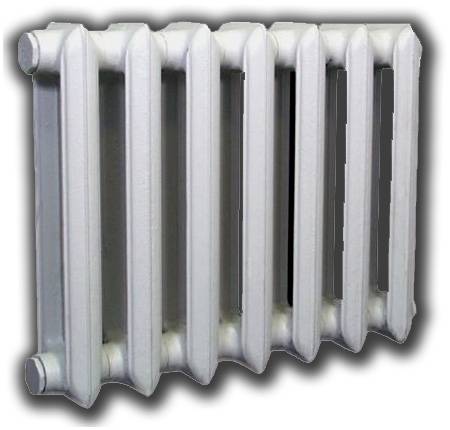
Cast iron radiators
These are the oldest radiators on the heating equipment market. They are distinguished by their solid dimensions, since they are made of thick cast iron. Such radiators withstand pressure drops, water hammer and high temperatures. They are also capable of working with aggressive coolants. Everything would be fine, but they are characterized by low heat dissipation, which makes them somewhat unsuitable for use in cold regions.
Their downsides also include:
- Inconvenience in installation - high weight affects;
- Not too attractive external data;
- Not suitable for use in high-rise buildings (above 5-9 floors).
Otherwise, these are good radiators, hardy and sturdy. Recently, quite modern models with acceptable dimensions and decent appearance have appeared on the market. And they can be installed in low-rise buildings, where they will serve for many years.
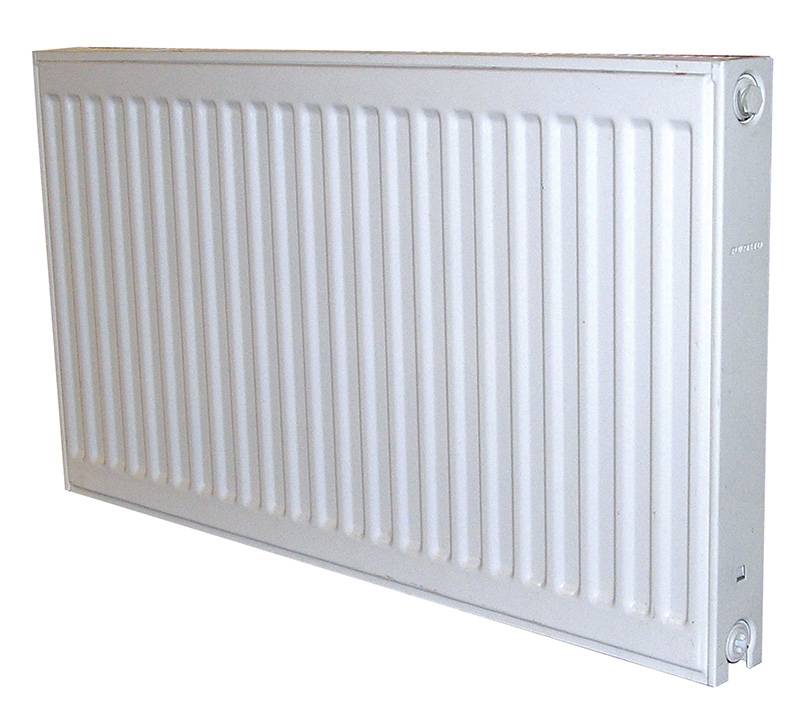
Steel radiators
Looking at modern steel panel radiators, you begin to immediately understand that they obviously cannot withstand high pressure. And this is really so, because thin metal is used here, which is not distinguished by expressive durability. Steel radiators can be useful for heating small private houses or summer cottages, but they are not suitable for use in high-rise buildings.
The only exceptions are some models of steel radiators, through which relatively thick pipes pass - their endurance is slightly higher. They are often called tubular radiators. Today they are found in some houses with a height of 9-16 floors.
Steel radiators are distinguished by high heat transfer and heat the premises well. They are also very lightweight and easy to install. The small internal volume is also an undoubted advantage. But all these advantages become useless if you need to install these radiators in an apartment - in low-rise buildings they will still serve (the use of tubular models is required), but in high-rise buildings they will not withstand high pressure.

Aluminum radiators
Modern aluminum radiators are lightweight and have high heat dissipation. And aluminum itself is a pretty strong metal. Radiators from it are ready to withstand the high pressure of the coolant, but there is no resistance to water hammer here. A no less disadvantage is the lack of resistance to the effects of the coolant - aggressive impurities literally corrode such radiators, leading to ruptures and leaks.
The appearance of aluminum radiators impresses with its magnificence - they are compact and neat, they are easy and pleasant to install, but the lack of resistance to water hammer and corrosion spoils everything. But they can be an excellent solution for private home ownership.
Sometimes it is allowed to use aluminum radiators in low-rise construction, where the coolant pressure is not as high as in high-rise buildings. They are also successfully used in apartments with individual heating.
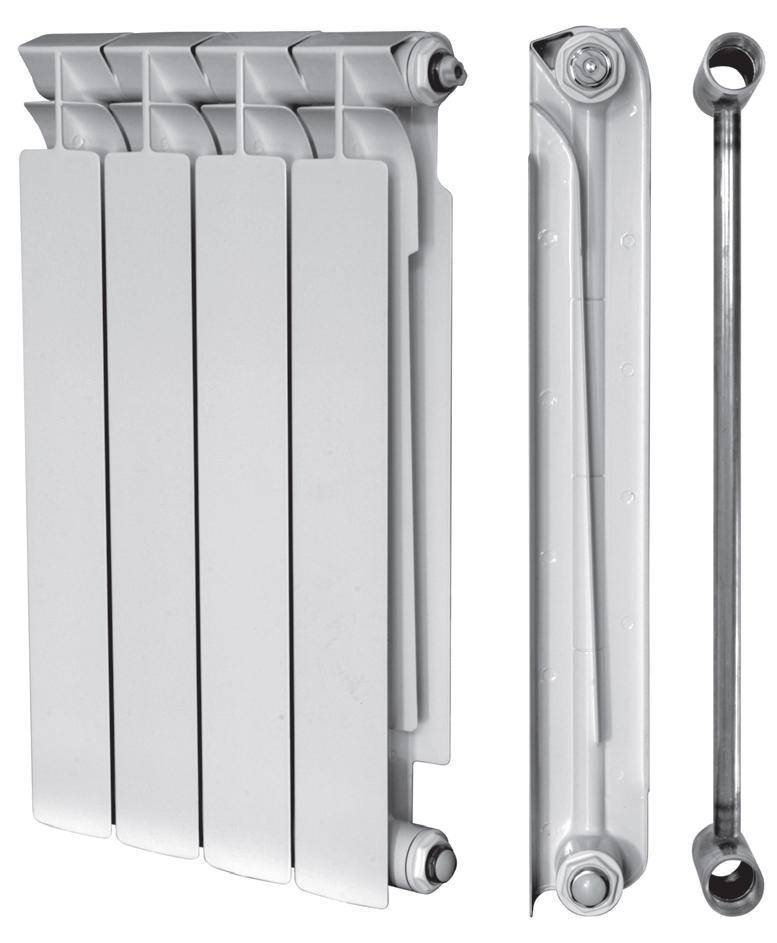
Bimetallic radiators
If you do not know which heating radiators are better to install in an apartment, then we recommend that you turn your attention to bimetallic models. Inside them we will find:
- Steel base - it can withstand pressure up to 50 atmospheres and is well resistant to corrosion;
- The aluminum case, which does not come into contact with the coolant, provides simply excellent heat dissipation.
Bimetallic radiators are not afraid of water hammer and high pressure, they are easy to assemble and dismantle. They are also not afraid of high temperatures and have a low weight, and due to the presence of effective protection against corrosion, they boast a long service life. It is bimetallic radiators that are the best for installation in apartments, be it a small three-story building or a solid 26-story building.
Despite the many advantages, bimetallic batteries have one disadvantage - they are high cost. Therefore, the cost of purchasing them will be quite significant.
Battery selection by operating pressure and heat output calculation
There is now a huge selection of heating radiators on the market. This somewhat complicates the choice of heating batteries, since you can make a mistake, and this will entail such consequences as ineffective operation of the heating system
If you need to know how to choose heating batteries in order to then buy them for an apartment, then the first thing you need to pay attention to is the thermal power of the device. In order to create the most optimal microclimate in the apartment, it is necessary that the heat transfer of the radiators is sufficient for a certain area for heating
The selection of heating radiators by area shows that 10 sq. meters of premises on average need 1 kW of heat. Therefore, if your apartment has 100 sq. meters, then you need a device that will generate 10 kW of heat per hour. If the apartment is located at the corner of the house or has at least one outer wall, then it will be necessary to add about 20% more thermal power.
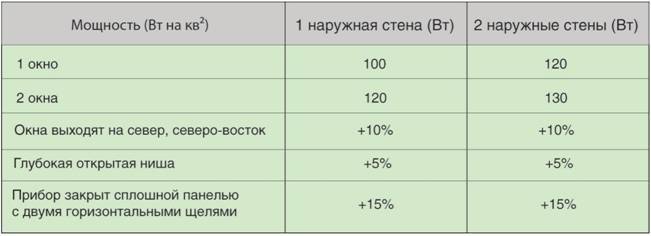 Selection of heating radiators by thermal power
Selection of heating radiators by thermal power
The next step is to find out what is the working pressure in the house and what is the temperature of the water in the heating devices and pipes, and then find out which types of heating radiators to choose. The answer to this question can be obtained by contacting the housing office or the house management service. It is necessary to know not only the working pressure, but also the test pressure. The size of the pressure can be obtained in various units of measurement. So, the choice of a radiator still largely depends on the pressure in the heating system of the whole house.
The test pressure will always be higher than the operating pressure. The test pressure is set once a year for a couple of hours in order to identify if there are weak points in the heating system.
What batteries are better to put in an apartment
We already know what threatens radiators in district heating systems. This is high pressure and water hammer - the rest can be neglected (to some extent). How do you choose heating radiators for an apartment and what are the requirements for them? Everything is easy and simple here, which will be described below.
Resistant to high pressure and water hammer
The best radiators for an apartment are those that can withstand high pressure. The higher the house, the higher the maximum possible pressure in the battery should be. You also need to remember about possible water hammer, so this figure is doubled. Considering that the pressure in the heating systems of high-rise buildings reaches 15-16 atmospheres, then the batteries must withstand a maximum pressure of up to 32 atmospheres.
For five-story houses, models with more modest indicators are suitable, since the pressure here is not so high - you need to navigate 16-20 atmospheres, taking into account possible hydraulic shocks.
Corrosion resistant

Many radiator models are subject to corrosion. Electrical corrosion is especially dangerous, which can occur at the junction of different metals.
Far from pure water flows in the pipes of heating systems. There are also quite aggressive components used to clean pipes and radiators from traces of corrosion. Together with rust and scale, aggressive components eat up metal. And if the same cast iron can still boast of durability, then aluminum under such influence is subject to destruction.Mechanical impurities require the use of a thick-walled metal that is resistant to mechanical stress.
Design and brand
Which heating batteries are best for an apartment, and which ones are better for a house? In private houses, we are free to use any heating batteries, since there we are independently responsible for the absence of water hammer and for the quality of the coolant. Therefore, there we often use fairly cheap radiators, from which great endurance is not required (especially if an open-type heating system is installed in the house).
As for apartment buildings, here you need to pay attention to the most durable batteries from leading brands. For example, it can be heating radiators from Kermi, Global or Fondital
Products from German manufacturers have the best quality, but here you need to be prepared for high costs. But such radiators can be used in heating radiators of any type - they are as reliable and durable as possible.
When it comes to Chinese batteries, there is always a chance of getting into trouble. For example, some manufacturers are openly "trash" by reducing the thickness of the metal. As a result, the batteries are thin and flimsy. Therefore, it is best to rely on European brands.

Modern models of semi-antique cast iron radiators.
Battery design is of paramount importance. Recently, thin panel and sectional radiators have become the most popular. They have an attractive appearance and good efficiency - manufacturers do their best to combine high build quality, excellent design and high heat dissipation. An interesting fact is that cast iron batteries began to appear on the market again, but now they have a rather interesting retro design.
It is cast-iron batteries that are able to withstand almost any trouble that heating systems can create. But this comes at the expense of their cumbersomeness and low efficiency.
High heat dissipation
Since we are talking about efficiency, then when choosing radiators, you need to pay attention to heat transfer. The higher this parameter, the warmer it will be in your apartment at the same coolant temperature.
Some models of aluminum and bimetallic heating radiators have a heat transfer of up to 200 W and more per section. For old cast-iron batteries, this figure is about one and a half times higher, but they are more reliable and durable.
Which are the best for central heating in an apartment
An important condition when choosing a radiator is a technical and structural component: heating networks in a house and a communal apartment give different pressure values. Autonomous (private house) - do not give out pressure more than 10 atm., And in the pipes of a communal apartment - 16 atm
Important! In communal apartments, pressure drops often occur - water shocks that damage the heating system; this rarely happens on autonomous networks. For an apartment (central heating), it is better to purchase: cast iron, aluminum and bimetallic radiators, since they tolerate high pressure and its drops well
For an apartment (central heating), it is better to purchase: cast iron, aluminum and bimetallic radiators, since they tolerate high pressure and its drops well.

In addition, copper or steel (panel) radiators are suitable for an apartment, but they are more sensitive to water hammer.
For a private house (autonomous network), you can choose any radiator, but since the pressure in the network is not so great, the best solution would be a steel, aluminum or copper radiator.
The electric heating system is suitable for any room with a normal humidity level.
How to determine the required diameter of the lines
When calculating the heating of a private house, this indicator should, of course, be calculated. With the wrong choice of the diameter of the lines, the system will not work effectively. To buy suitable pipes, you first need to decide:
with the thermal power of the system;
optimal pressure of the coolant.
The first indicator is calculated according to the formula Q = (V * Δt * K) * 860, where V is the volume of the room, Δt is the difference in air temperatures in the room and outside, K is a correction factor (depends on the degree of insulation of the building and is determined according to a special table) ...
The optimal speed of movement of the coolant in the system is 0.36-0.7 m / s. The obtained value of the thermal power and the selected pressure indicator should simply be substituted into the table for determining the diameter of the pipes.
As for the material of the highways, nowadays, both in small country houses and in cottages, metal-plastic is usually used. However, if desired, steel or even expensive and very durable copper pipes can be supplied in a private residential building.

Bimetal radiators
The bimetallic radiator combines the high strength and durability of a steel heating register and the excellent thermal performance of aluminum convectors.
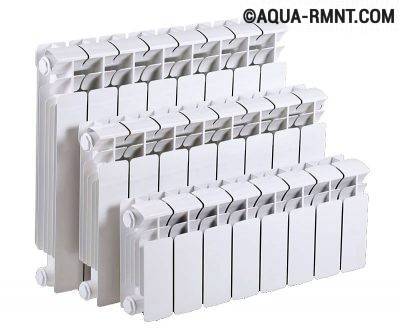
Bimetallic radiators are indistinguishable from aluminum devices, but they have higher reliability and durability
The internal channels of the device are welded from solid-drawn steel pipes, due to which the battery can withstand a pressure of more than 50 atmospheres and perfectly resists corrosion. An aluminum casing with convection ribs is fused onto this skeleton. As a result of this trick, it is possible to obtain a product with maximum heat transfer, low thermal inertia and a service life of up to 25 years.
Technical characteristics of popular bimetallic radiators. The table is available in large size by clicking.
In addition to the monolithic bimetallic radiators described above, the industry produces aluminum-steel heat exchangers assembled from separate sections. The composite battery loses to the inseparable design in terms of reliability and durability, but it has advantages in the form of flexible adjustment of thermal power. All you need to do is add or remove a few additional sections. In addition, the indisputable advantage of type-setting bimetallic batteries is their high maintainability.
STOUT Space bimetallic radiators combine ease of installation, no-frills aesthetics and a reliable design that can withstand pressures of over 100 atmospheres. Products are manufactured at the largest Russian plant "RIFAR" and comply with GOST 31311-2005 "Heating devices". The maximum temperature of the coolant is 135 ° C, the manufacturer's warranty is 10 years, the service life is 25 years. The available number of sections is from 4 to 14: bimetallic radiators can be installed both in a small kitchen and in the living room of a private house.
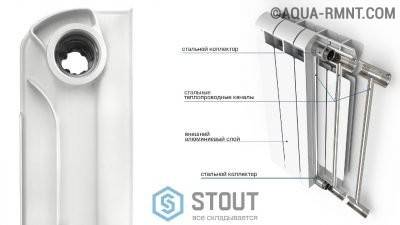
Sectional STOUT bimetal heating radiator. Steel heat exchanger circuit and aluminum fins make the bimetallic radiator as durable and efficient as possible
The available number of sections is from 4 to 14: bimetallic radiators can be installed both in a small kitchen and in the living room of a private house.

Bimetallic heating radiator STOUT for 8 sections
When making your choice in favor of the most technologically advanced of all existing radiators, do not be fooled. In order to save materials and reduce the price of the final product, manufacturers use tricks. In some models, not a monolithic contour is made of steel pipes, but only vertical radiator channels.As for the horizontal working cavities, they are cast simultaneously with the aluminum body.
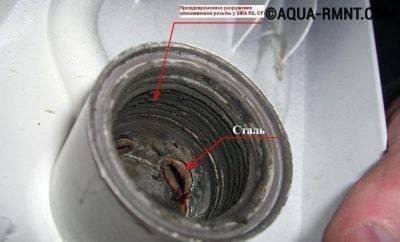
In semi-metallic radiators, only vertical channels are made of steel, therefore, in terms of reliability and durability, they do not differ from aluminum ones.
Features of operation
To determine which heating device you need to purchase, you need to clearly formulate the main technical and aesthetic parameters of the selection. In a city apartment, aesthetics play an important role. After all, the traditional location of the radiator - under the window - is available for public viewing.
It is very important that the appearance of the device is attractive, or at least not disgusting. Sometimes homeowners try to solve the issue with decorative grilles, long curtains or in some other way.
Such solutions will invariably lead to a deterioration in heat transfer and a decrease in the average daily temperature in the house.
According to the standards that were inherited from the USSR along with centralized heat supply systems, the pressure of the system should be 5 atmospheres, and the temperature of the coolant should be 95 degrees Celsius. It is hardly worth proving to someone that these parameters are not always observed. His Majesty the human factor often makes its own corrections.
The damper not closed in time during the test period will easily make all the batteries of the house shudder from a pressure of 12-20 atmospheres - and this is the minimum. One should not exclude the possibility of a water hammer, which is often caused by objective reasons. The pressure in the system in this case is difficult to predict
Therefore, it is very important that radiators can withstand such severe tests. Otherwise, major unscheduled repairs are guaranteed.
Cast iron radiators
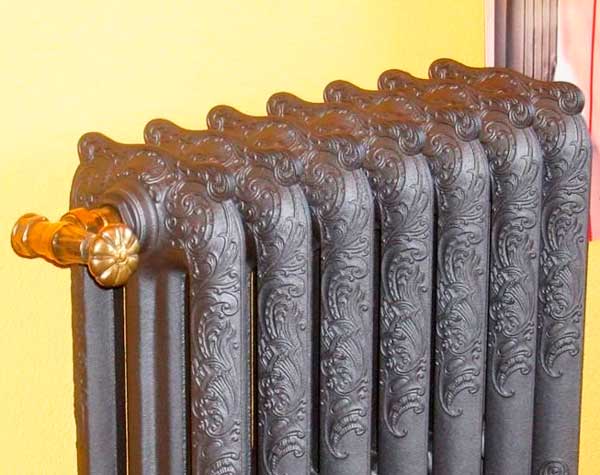 This type of radiator was used in Russia even under the tsar. In the houses that were built during the Soviet era, they still serve faithfully.
This type of radiator was used in Russia even under the tsar. In the houses that were built during the Soviet era, they still serve faithfully.
Cast iron batteries take a long time to heat up, but they cool down for a long time. The residual heat retention number is twice that of other types and amounts to 30%.
This makes it possible to reduce the cost of gas for heating the house.
Advantages of cast iron radiators:
- Very high corrosion resistance;
- Durability and reliability, which have been proven over the years;
- Low heat transfer;
- Cast iron is not afraid of exposure to chemicals;
- The radiator can be assembled from a different number of sections.
Cast iron radiators have only one drawback - they are very heavy.
The modern market offers cast iron radiators with decorative design.
Calculation of the power of heating radiators for an apartment
 Power calculation table for aluminum and bimetallic batteries
Power calculation table for aluminum and bimetallic batteries
For a normal microclimate in a residential area, the heating radiator should not cover 70-75% of the width of the window opening. Then the cold air from the window and warm air from the battery mix freely and move around the room, without fogging the glasses. Therefore, instead of 5-6 powerful sections, it is better to put 8-10 sections with less power, but occupying the required area under the window.
To find out the required power of the radiator, you need to multiply the area of the room by 100 W. If:
- In the room there is 1 window or outer door and 2 outer walls, then the capacity of the battery is increased by 20%;
- 2 windows and 2 external walls - by 30%;
- The window faces north or northeast - 10%;
- The battery in the niche - by 5%;
- The radiator is covered with a panel with slots - 15%.
Choosing heating radiators for a private house which is better

Consider the main advantages of the heating system of a private house:
- Its work is carried out at low pressure, which favorably affects the operation;
- In this system, there are no large hydro-shocks, this provides a wide range of radiator selection;
- Observing the necessary technical conditions for the acid balance of water, the choice of radiators is very wide.
Taking into account the above, the choice of radiators should be carried out taking into account the maximum heat transfer coefficient and a good price-quality ratio. If you do not go into details, any type of radiator can be used in a private house.But knowing the benefits of one or the other still does not hurt.
For the manufacture of radiators, the following types of materials are used: cast iron, aluminum, metal (steel), bimetal.
How to choose a heating radiator for an apartment
When the main characteristics of the devices are indicated, it is easier to decide
Regardless of which batteries for heating an apartment you liked, when making a purchase, you need to take everything into account, from the footage of the rooms to the place of installation. Do not forget about the dubious quality of the coolant: it is better to play it safe once again
Check out the practical tips to help you understand which radiators are best for your apartment:
- It is necessary to calculate the capacity of the installation for your room. The required value is equal to the product of the volume and the required heat flow for standard buildings (0.41 kW).
- Find out the amount of coolant in the system. If there is little water, then it is better to give preference to steel, aluminum or bimetallic models. In cases where natural circulation heating is planned, choose cast iron.
- Determine the installation location. The size of the systems and the required heat transfer will largely depend on this.
- For a room with 1 window and external walls, the power of the device should be increased by 20-30%.
Features of the choice of heating devices
Now people no longer need to hide or decorate radiators, since modern appliances can become a worthy decoration for any interior. The radiators sold today can vary in color, size, material of manufacture and general style of execution, so it will not be difficult to choose the most suitable option.
Heating radiators
With regards to the form, it must be streamlined. For safety reasons, it is advisable to abandon sharp corners altogether, especially if children live in the house. Before buying, familiarize yourself with the strengths and weaknesses of each of the existing types of radiators to determine which one is more suitable for a particular room.
The first thing to pay attention to is the working pressure of the instruments.
How to choose heating radiators
Depending on the material, radiators are divided into:
- aluminum;
- bimetallic (from alloys of two metals);
- cast iron;
-
steel.
The above-mentioned pressure, heat transfer coefficient, heat capacity, resistance to mechanical and chemical damage, as well as service life depend on the material.
Interior radiators
Also pay attention to the way of connection to the heating main. The connection can be side, bottom and universal
It is characteristic that modern radiators provide for all these connection methods.
Radiator connection options
Now in more detail about each material.
How to calculate the power of radiators and the number of sections in an apartment

When buying a device, it is important to correctly determine its dimensions. Too small battery will not warm up the room in winter, and too large will entail unnecessary heating costs
To determine the required characteristics of the device for a standard apartment with a low ceiling height (2.4-2.6 m) use a simple formula.
The area of the room is multiplied by 100 watts and divided by the section power indicated in the datasheet or on the manufacturer's website. The result is rounded up. The heat transfer of the device will be equal to the product of the obtained value by the power of one element. The exception is the kitchen - there the fractional part is discarded.
If the house has high ceilings, then you can use the calculation by volume. According to SNiP, 41 W of power is required to heat one cubic meter (34 W if double-glazed windows are installed).To determine the required number of sections, the volume of the room is multiplied by 41 and divided by the heat transfer of one element.
Correction factors:
- if the room has a balcony or is located in the corner of a building, the result is multiplied by 1.2;
- in the room there are two windows - by 1.3;
- the device is covered with a solid panel - by 1.15;
- in the regions of the Far North - by 1.6.
Steel radiators
Like other heating equipment with open welds, steel radiators require a stable heating medium pressure. For this reason, they are most often used for installation in private houses and other buildings with autonomous heating. In this case, a closed heating circuit slows down oxidative processes, besides, individual heating does not suffer from constant contamination of the coolant with alkali and other aggressive impurities. When using purified water and regular monitoring of the pressure, steel radiators do not need to be replaced for 20 years or more.

Technical characteristics of steel radiators from well-known European manufacturers
When installing steel radiators in buildings with central heating, one should be aware of the danger of water hammer and poor quality of the coolant. Sudden pressure drops and water with salt and alkali impurities reduce the battery life by more than half. In this case, you should not expect the equipment to last more than 10 years.
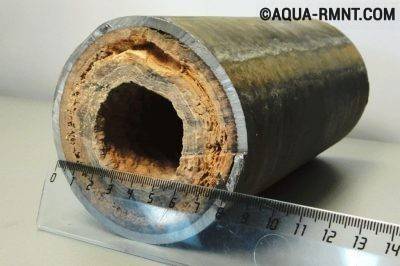
Such deposits in the central heating pipe indicate a strong contamination of the coolant with impurities - in this case, it is better not to use steel radiators.
There are two types of steel radiators on sale:
- tubular,
- panel.
The advantages of the former stem from a simple and reliable design that resembles a ladder of parallel vertical tubes.

Tubular radiators are experiencing a second youth, being the object of attention of designers and lovers of modern trends in the interior.
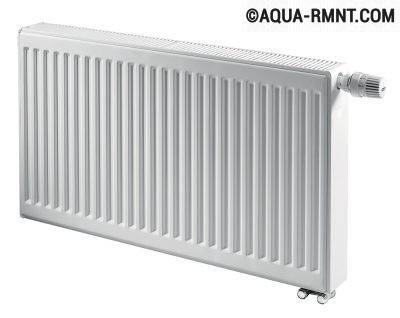
Flat, level surfaces of panel radiators make maintenance much easier. That is why housewives love them so much.
For the manufacture of panel radiators, steel zigzag plates are used, which are spot welded to each other. The cavities formed in this case serve as channels through which the coolant circulates. To increase heat transfer, manufacturers complicate the design by assembling a radiator from three panels. The downside of this improvement is the heavier structure - the weight of multilayer steel heat exchangers approaches that of cast iron.

For the manufacture of a panel radiator, profile steel plates are used, the space between which acts as a water circuit of the heat exchanger
As you yourself can see, the advantages of panel radiators, such as low price and attractive appearance, overshadow the disadvantages in the form of low performance. Most often, these heating devices are chosen for undemanding budget heating systems.
Plastic radiators
At the moment, heating radiators are made entirely of plastic, a kind of know-how. Russian engineers in Skolkovo are also working on this type of heater. Contrary to popular belief, in terms of reliability, plastic radiators are close to metal products, and in terms of corrosion resistance, they have no equal at all. Thermoplastic products have high mechanical strength, good thermal conductivity and wear resistance. Plastic radiators are not very heavy, so they are easy to transport and install.
Plastic heatsink diagram
Ease of manufacture and, as a result, low cost make thermoplastic batteries an excellent offer for those who set themselves the task of saving money. A significant disadvantage of plastic heat exchangers is that they can only be used in systems with a stable pressure of up to 3 atm and a coolant temperature of no higher than 80 ° C. For this reason, the promotion of plastic batteries in our market is difficult.
How to distinguish a quality radiator
Usually, buyers are offered a warranty card for the purchased product.High-quality radiators will serve not only during the warranty period, but also for many years after its expiration.
Be sure to ask for the warranty card at points of sale and keep it for the entire warranty period
The same cannot be said about Chinese radiators made of recycled materials and covered with paint that peels off at the first mechanical impact.
Heating battery defect
Is it worth saving on quality so that after the very first crimping the radiator turns into scrap metal?
How to recognize a Chinese counterfeit?
- Visually inspect the radiator. The coating should be uniform, without scratches and flaking, homogeneous.
- Evaluate the quality of the radiator edges. Low-quality models have sharp edges, you can even cut yourself on them. Discard such devices without hesitation.
- If possible, estimate the weight of one section of the radiator. The lower the weight, the lower the thermal conductivity of the device, the worse the quality. Thus, an aluminum section with a center-to-center distance of 500 mm should not weigh less than one kilogram. If the section weighs less, then provided that the temperature head ΔT = 70 ° C, the thermal conductivity does not exceed 140 W / m * K.
Always inspect the product before purchasing
Comparison of the thermal conductivity index of various radiators is presented in the table.
| Radiator type | Center-to-center distance, mm | Weight of 1 section | Heat transfer, W / m * K (average indicators) |
|---|---|---|---|
| Aluminum | 500 | 1,45 | 183 |
| Aluminum | 350 | 1,2 | 139 |
| Bimetallic | 500 | 1,92 | 204 |
| Cast iron | 350 | 7,12 | 160 |
In some models, heat transfer is increased due to the presence of vertical fins or channels.
Use our calculator to calculate the required number of radiator sections.
Features of the central heating system
Most apartments in Russia have centralized heating. It works in a closed circle: the heating unit heats the coolant, and the pumps, creating pressure, distribute it to the apartments.

In domestic systems, there are many factors that negatively affect radiators.
Liquid is often drained and filled.
The process water flowing through the pipes contains a large amount of debris, impurities and small particles that scratch the radiator and clog its interior. It is chemically aggressive and can corrode metals.
The magnitude of the pressure often changes. In the heating system, drops in the level of the coolant in the main lines sometimes occur, causing water shocks. The reasons are different: for example, too abrupt closing of the pumping station valve or the ingress of a large amount of air into the pipes.
The devices must withstand these negative influences.
Attention! Compatibility of apartment piping materials and battery connection devices is required. Otherwise, the contact of dissimilar metals will lead to an accident
Types of radiators for an apartment, their main characteristics, price
Cast iron sectional devices

Modern models differ from the usual oil-painted batteries. They are attractive, durable and reliable.
Product advantages:
- Undemanding to the coolant. Cast iron is a chemically passive material that does not corrode. A protective film is created inside the radiator to prevent its destruction. Small abrasive particles in the water do not damage the thick walls of the product.
- Ability to withstand high pressure in the system: operating - from 6 to 10 atm., Test - up to 18 atm. The devices successfully resist water hammer.
- Long service life. If the devices are regularly washed, they will last 50 years or more.
- Convenient sectional system. You can buy the optimal number of cells and mount the batteries of the required length.
- Low price: 2500-3000 rubles. for 4-6 sections.
Disadvantages:
- Large mass.
- A significant amount of coolant is required for work.
- The devices are slow to warm up and cool down and therefore cannot be used in regulated systems.
- The devices have to be washed frequently due to the rough inner walls, into which particles and impurities are clogged.
- The surface of the batteries is regularly painted, as the coating quickly cracks.
Made of aluminum
These are stylish modern constructions of various designs. Manufacturers produce sections of different heights and lengths from which the batteries are assembled. When choosing, consumers take into account the characteristics of a particular room. There are models for every taste and wallet.
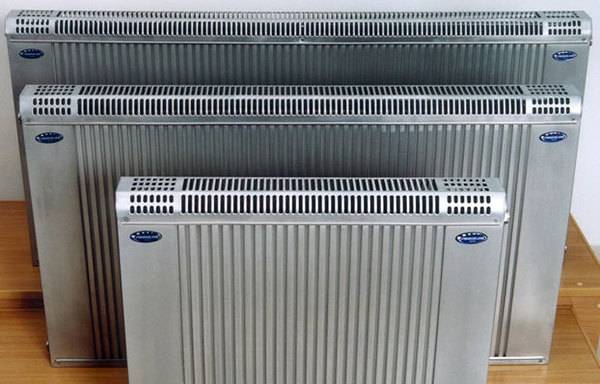
Photo 1. Heating radiators made of aluminum. The devices are available in different sizes.
Advantages:
- devices heat up the room easily;
- they are small in size and weight;
- they are able to withstand high pressure - from 16 to 20 atm .;
- thermal power - about 190 W;
- attractive and varied design;
- affordable price - from 120 rubles. per section.
Disadvantages:
- sensitivity to contamination of the coolant;
- poor corrosion resistance;
- when the heating is turned off, the devices cool down quickly;
- they cannot be used in conjunction with copper or brass fittings - this will lead to rust and damage to the radiators.
Steel structures
Devices are of two types: panel and tubular. The first are inexpensive devices made of steel sheets with channels for the coolant. They are used in all types of homes.
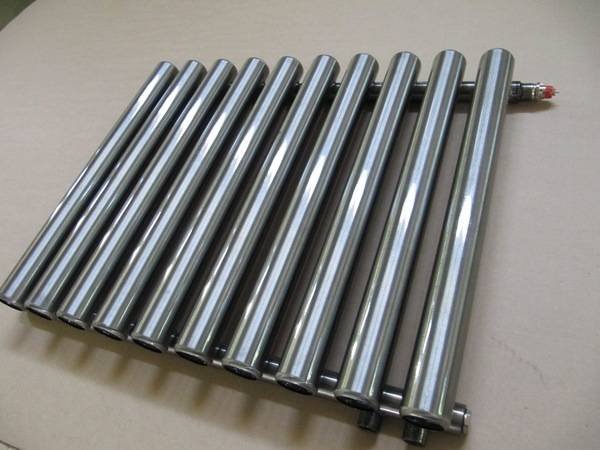
Photo 2. Steel tubular radiators for heating. The device has a rather attractive design.
Tubular - premium class products with a designer look. Especially attractive are stainless steel radiators - expensive devices that are installed in luxury homes.
Advantages:
- various options for implementation;
- a small amount of coolant required for work;
- products heat up quickly and give off heat well.
Disadvantages of panel radiators:
- low working pressure - from 6 to 10 atm .;
- poorly withstand water hammer;
- short period of operation - 10 years;
- there is no corrosion protection inside the product.
Tubular radiators have better workmanship. Their working pressure is 15 atmospheres, and the service life is up to 25 years.
Bimetallic batteries
The devices consist of a steel inner loop and outer plates made of aluminum... The collectors can withstand high pressure. They are compatible with all metal fittings and pipes. Aluminum plates conduct heat well.
Enterprises produce both cast models without seams, and devices from separate sections, which are connected by nipples and gaskets.
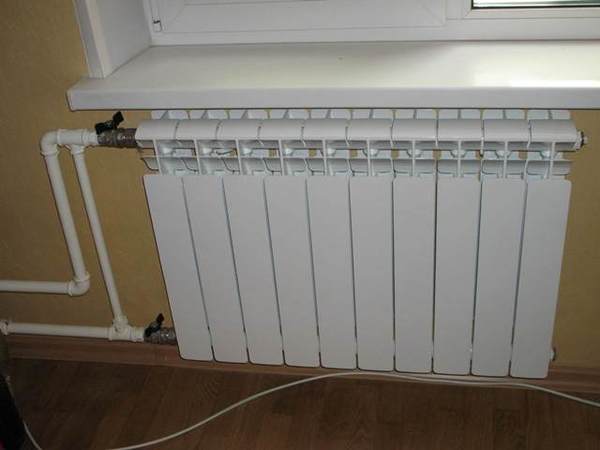
Photo 3. Bimetallic heating radiators. They are currently the most popular.
Advantages:
- high heat output;
- small volume of liquid;
- good resistance to aggressive environments;
- pressure up to 35 atm .;
- long service life - up to 25 years.
Lack of products - high price. One section costs from 450 rubles.
For houses with central heating, it is better to use cast iron and bimetallic devices.
For low-rise buildings - steel radiators are added to them.
Aluminum products are suitable for closed systems in which the quality of the coolant is checked.
